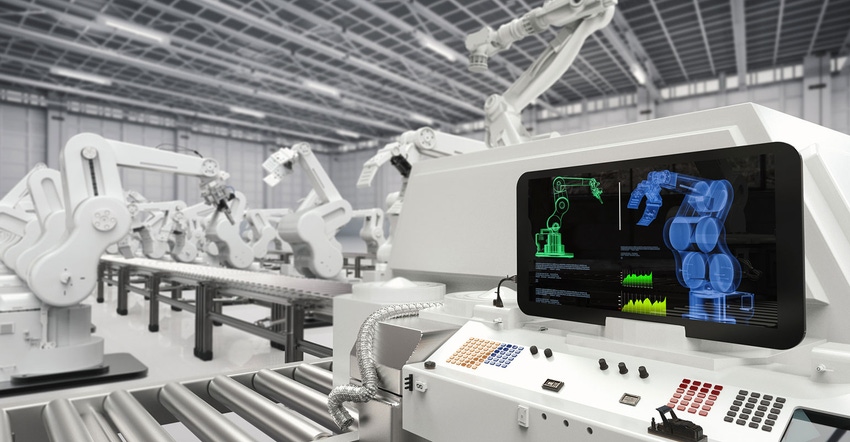Two senior analysts at the IIoT research and advisory firm LNS Research predict what's in store for 2018.
December 20, 2017

By IOT Content Manager
In the world of IIoT and digital transformation for industry, the past year has been one to remember. Many will look back at this being the year where we passed peak hype and moved from talking about the realm of the possible to the practical.
Despite some high-profile setbacks for vendors in the space, there is still more positive momentum than negative, and LNS Research believes that even as we move into a post-peak hype era, there will be many winners — both vendor and end user. In this article, president and principal analyst at LNS Research Matthew Littlefield and principal analyst Dan Miklovic project what’s ahead for IIoT in the coming year.
1. Large industrials reinvent operational excellence (Matt Littlefield)
Pundits have long characterized the industrial space as insular, organic and conservative in how it approaches the adoption of technology and process improvement techniques. Lean manufacturing, which began to spread throughout the world in the 1980s, was developed out of the Toyota Production System and other successful Japanese manufacturers. Six Sigma was developed out of Motorola in the early 1980s and became a guiding principle for GE under Jack Welch in the 1990s. In both cases these systems delivered best-in-class results to the early adopters; then were codified and organically adopted across industries through the work of academics, consultants and technology providers.
[Internet of Things World demonstrates how the next generation of IoT will converge to unlock the intelligence of things in the industrial, enterprise and consumer realms. See what’s new for 2018.]
As these methodologies spread, however, some interesting phenomena occurred. First, the processes that developed evolved to take advantage of the technology available at the time. Second, the processes themselves became hardened — and in some circles even turned to dogma — meaning as technology advanced, the process itself couldn’t change without severe repercussion and criticism.
LNS believes that 2018 will be the year this dogmatic approach breaks down… and a new breed of large industrial companies will emerge and publicly prove through improved best-in-class results that a new approach to Lean and Six-Sigma is needed to fully capture the potential benefits of digital technology in manufacturing.
2. IIoT Platform adoption gains critical mass in the industrial sector (Matt Littlefield)
Last year we predicted that 2017 would be the year where we saw IIoT platform providers move from pilot to enterprise roll-outs with more than one vendor going on the record with customers making enterprise commitments. And we were right, with two major startups in the space announcing big wins. C3IoT has gone enterprise-wide with Enel (the largest utility in Italy) and Uptake has gone enterprise-wide with Caterpillar Progress Rail (monitoring 5,000 trains).
In 2018, we believe it will be the year that some of the platform players gain critical mass — i.e. gain multiple major customers on the same multi-tenant platform with shared services and apps running across. There will, however, be some caveats. It will not be a one-platform-to-rule-them-all architecture. LNS does believe that each end user will have multiple platforms for multiple use cases and inter-cloud connectivity will become both a requirement and reality. We also believe that IIoT platforms (not including cloud platforms like Azure and AWS) will have to differentiate on subject matter expertise and relevance. So different platforms may offer similar analytics and apps but have specific industry strength and adoption around utilities, oil and gas, transportation or manufacturing, to cite several examples.
3. APM Becomes all About Business (Dan Miklovic)
Ever since the advent of Asset Performance Management (APM), the focus has been on improving reliability, decreasing downtime and reducing unplanned maintenance. Most of this has been predicated on the premise if “it’s” broken “it” can’t be contributing to the business. There is the assumption that minimizing downtime improves profitability and the best way to minimize downtime is to “fix” equipment before it fails, catastrophically. The problem with this assumption is that the act of maintaining a piece of equipment can by itself, cause further failures. In the past, industry professionals have applied analytics to predicting when a piece of equipment will fail and then doing preventative maintenance so it doesn’t fail at an unexpected time. We see 2018 as being the year the focus shifts towards actually optimizing the profitability from equipment. Machine learning and improved Big Data Analytics will enable business to decide the best operating profile for the plant based on the order backlog, reliability issues and the Digital Twin model of the plant. In 2017, we saw the introduction of these concepts with Schneider Electric’s “Profit Advisor” solutions and GE’s Operations Performance Management (OPM) products, among others. Expect more in 2018.
4. Digital twins in 2018 simulate possible futures (Dan Miklovic)
Just as with the focus of analytics, much of the hype around digital twins in asset-intensive industries has been about maintenance-focused applications such as superimposition of operating conditions on virtual X-rays of the equipment to aid technicians in diagnosis or using the twin to model expected service life. The twin has been the basis for the growth of AR/VR tools to help technicians perform service tasks better as well. In 2018 we expect the Digital Twin focus to shift to include not just the physical aspects of the twin but the process aspects as well. This trend will drive new interest in process design and engineering applications so changes in operating performance required to facilitate reliability can be assessed for production impacts, as noted above. This expanded use of the Digital Twin to provide alternate future states and make recommendations as to possible course of actions will change the concept of what a Digital Twin is.
You May Also Like
.png?width=700&auto=webp&quality=80&disable=upscale)
.png?width=700&auto=webp&quality=80&disable=upscale)

.png?width=300&auto=webp&quality=80&disable=upscale)
.png?width=300&auto=webp&quality=80&disable=upscale)
.png?width=300&auto=webp&quality=80&disable=upscale)
